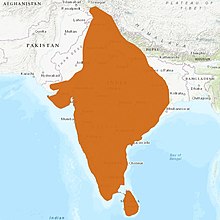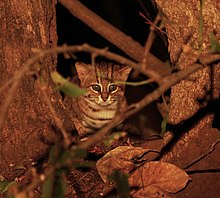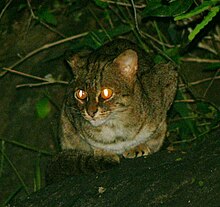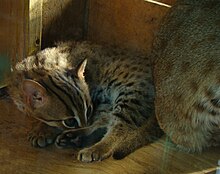Rusty-spotted cat
| Rusty-spotted cat | |
|---|---|
 | |
Conservation status | |
CITES Appendix I (CITES)[2] | |
| Scientific classification | |
| Domain: | Eukaryota |
| Kingdom: | Animalia |
| Phylum: | Chordata |
| Class: | Mammalia |
| Order: | Carnivora |
| Suborder: | Feliformia |
| Family: | Felidae |
| Subfamily: | Felinae |
| Genus: | Prionailurus |
| Species: | P. rubiginosus[1] |
| Binomial name | |
| Prionailurus rubiginosus[1] (Geoffroy Saint-Hilaire, 1834) | |
 | |
range of the rusty-spotted cat in 2016[2] | |
The rusty-spotted cat (Prionailurus rubiginosus) is one of the cat family's smallest members, of which historical records are known only from India and Sri Lanka.[3] In 2012, it was also recorded in the western Terai of Nepal.[4] Since 2016, the global wild population is listed as Near Threatened on the IUCN Red List as it is fragmented and affected by loss and destruction of its prime habitat, deciduous forests.[2]
Taxonomy
Felis rubiginosa was the scientific name used by Isidore Geoffroy Saint-Hilaire in 1831 for a rusty-spotted cat specimen from Pondicherry, India.[5] Prionailurus was proposed by Nikolai Severtzov in 1858 as a generic name.[6] Prionailurus rubiginosus phillipsi was proposed by Reginald Innes Pocock in 1939 who described a specimen from Central Province, Sri Lanka and subordinated both to the genus Prionailurus.[3]
Phylogeny
Phylogenetic analysis of the nuclear DNA in tissue samples from all Felidae species revealed that the evolutionary radiation of the Felidae began in Asia in the Miocene around 14.45 to 8.38 million years ago.[7][8] Analysis of mitochondrial DNA of all Felidae species indicates a radiation at around 16.76 to 6.46 million years ago.[9]
The Prionailurus species are estimated to have had a common ancestor between 8.16 to 4.53 million years ago,[7] and 8.76 to 0.73 million years ago.[9] The rusty-spotted cat possibly genetically diverged from this ancestor between 6.54 to 3.42 million years ago.[7] Both models agree in the rusty-spotted cat having been the first cat of this lineage that diverged, followed by the flat-headed cat (P. planiceps) and the fishing cat (P. viverrinus).[7][9] The following cladogram shows the phylogenetic relationships of the rusty-spotted cat as derived through analysis of nuclear DNA:[7][8]
|
Characteristics

The rusty-spotted cat has a short reddish grey fur over most of the body with rusty spots on the back and flanks. Four blackish lines run over the eyes, and two of them extend over the neck. Six dark streaks are on each side of the head, extending over the cheeks and forehead. Its chin, throat, inner side of the limbs and belly are whitish with tiny brownish spots. It has a rusty band on the chest. Its paws and tail are uniform reddish grey.[5]
It is the smallest wild cat in Asia and rivals the black-footed cat as the world's smallest wild cat. It is 35 to 48 cm (14 to 19 in) in length, with a 15 to 30 cm (5.9 to 11.8 in) tail, and weighs only 0.9 to 1.6 kg (2.0 to 3.5 lb). The bushy tail is about half the length of the body.[10]
Distribution and habitat
The distribution of the rusty-spotted cat is relatively restricted. It occurs mainly in moist and dry deciduous forests as well as scrub and grassland, but is likely absent in evergreen forest.[11] It prefers dense vegetation and rocky areas.[12][13]
In India, it was long thought to be confined to the south, but records have established that it occurs over much of the country.[11] It was observed in eastern Gujarat's Gir National Park, in Maharashtra's Tadoba-Andhari Tiger Reserve and along India's Eastern Ghats.[13][14][15][16][17] Camera trapping revealed its presence in Pilibhit Tiger Reserve in the Indian Terai and in Nagzira Wildlife Sanctuary in Maharashtra.[18][19]
In western Maharashtra, the rusty-spotted cat is breeding in a human dominated agricultural landscape, where rodent densities are high.[20] In December 2014 and in April 2015, it was photographed by camera traps in Kalesar National Park, Haryana.[21] It was also recorded by camera traps in Mirzapur Forest Division of Uttar Pradesh in 2018.[22]
In March 2012, a rusty-spotted cat was photographed in Bardia National Park for the first time, and in March 2016 also in Shuklaphanta National Park, both in Nepal.[4][23]
In Sri Lanka, there are a few records in montane and lowland rainforest. There are two distinct populations, one in the dry zone and the other in the wet zone.[24] In 2016, it was recorded for the first time in Horton Plains National Park at elevations of 2,084–2,162 m (6,837–7,093 ft).[25]
Ecology and behaviour


Very little is known about the ecology and behaviour of the rusty-spotted cat in the wild. Captive ones are mostly nocturnal but also briefly active during the day.[10] Most wild ones were also recorded after dark. At Horton Plain National Park in Sri Lanka, they were mostly recorded between sunset and sunrise, with limited daytime activity.[25] Several individuals were observed hiding in trees and in caves.[26][27][28]
It feeds mainly on rodents and birds, but also preys on lizards, frogs, and insects. It hunts primarily on the ground, making rapid, darting movements to catch its prey. It apparently ventures into trees to escape larger predators. Captive females and males both scent-mark their home range by spraying urine.[10]
Reproduction

The female's oestrus lasts five days, and mating is unusually brief. Since the female is likely to be vulnerable during this period, its brevity may be an adaptation to help it avoid larger predators. She prepares a den in a secluded location, and after a gestation of 65–70 days gives birth to one or two kittens. At birth, the kittens weigh just 60 to 77 g (2.1 to 2.7 oz), and are marked with rows of black spots. They reach sexual maturity at around 68 weeks, by which time they have developed the distinctive adult coat pattern of rusty blotches. Rusty-spotted cats have lived for twelve years in captivity, but their lifespan in the wild is unknown.[10]
Threats
Habitat loss and the spread of cultivation are serious problems for wildlife in both India and Sri Lanka. Although there are several records of the rusty-spotted cat in cultivated and settled areas, it is not known to what degree these populations are able to persist in such areas. There have been occasional reports of rusty-spotted cat skins in trade.[11] In some areas, it is hunted for food or as livestock pest.[10]
Conservation

The Indian population is listed on CITES Appendix I. The Sri Lankan population is included on CITES Appendix II. The species is fully protected over most of its range, with hunting and trade banned in India and Sri Lanka.[2]
As of 2010, the captive population of P. r. phillipsi comprised 56 individuals in eight institutions, of which 11 individuals were kept in the Colombo Zoo in Sri Lanka and 45 individuals in seven European zoos.[29]
Local names
In Sri Lanka, the rusty-spotted cat is known as kola diviya (කොළ දිවියා) or balal diviya (බළල් දිවියා).[30]
References
- ^ Wozencraft, W. C. (2005). "Species Prionailurus rubiginosus". In Wilson, D. E.; Reeder, D. M. (eds.). Mammal Species of the World: A Taxonomic and Geographic Reference (3rd ed.). Johns Hopkins University Press. pp. 543–544. ISBN 978-0-8018-8221-0. OCLC 62265494.
- ^ a b c d e Mukherjee, S.; Duckworth, J.W.; Silva, A.; Appel, A. & Kittle, A. (2016). "Prionailurus rubiginosus". IUCN Red List of Threatened Species. 2016: e.T18149A50662471. doi:10.2305/IUCN.UK.2016-1.RLTS.T18149A50662471.en. Retrieved 16 January 2022.
- ^ a b c Pocock, R. I. (1939). "Prionailurus rubiginosus Geoffroy. The Rusty-spotted Cat". The Fauna of British India, including Ceylon and Burma. Vol. Mammalia. – Volume 1. London: Taylor and Francis Ltd. pp. 276–280.
- ^ a b Appel, A. (2016). "The first records of Rusty-spotted Cat in Nepal" (PDF). Small Wild Cat Conservation News (2): 8–10. Archived from the original on 2023-08-12. Retrieved 2018-02-10.
- ^ a b Geoffroy Saint-Hilaire, I. (1831). "Le Chat à Taches de Rouille, Felis rubiginosa (Nob.)". In Bélanger, C.; Geoffroy Saint-Hilaire, I. (eds.). Voyage aux Indes-Orientales par le nord de l'Europe, les provinces du Caucases, la Géorgie, l'Arménie et la Perse, suivi des détails topographiques, statistiques et autre sur le Pégou, les Iles de Jave, de Maurice et de Bourbon, sur le Cap-de-bonne-Espérance et Sainte-Hélène, pendant les années 1825, 1826, 1827, 1828 et 1829. Tome 3: Zoologie. Paris: Arthus Bertrand. pp. 140–144.
- ^ Severtzow, M. N. (1858). "Notice sur la classification multisériale des Carnivores, spécialement des Félidés, et les études de zoologie générale qui s'y rattachent". Revue et Magasin de Zoologie Pure et Appliquée. X: 385–396.
- ^ a b c d e Johnson, W. E.; Eizirik, E.; Pecon-Slattery, J.; Murphy, W. J.; Antunes, A.; Teeling, E. & O'Brien, S. J. (2006). "The Late Miocene radiation of modern Felidae: A genetic assessment". Science. 311 (5757): 73–77. Bibcode:2006Sci...311...73J. doi:10.1126/science.1122277. PMID 16400146. S2CID 41672825. Archived from the original on 2020-10-04. Retrieved 2020-05-04.
- ^ a b Werdelin, L.; Yamaguchi, N.; Johnson, W. E. & O'Brien, S. J. (2010). "Phylogeny and evolution of cats (Felidae)". In Macdonald, D. W. & Loveridge, A. J. (eds.). Biology and Conservation of Wild Felids. Oxford, UK: Oxford University Press. pp. 59–82. ISBN 978-0-19-923445-5. Archived from the original on 2018-09-25. Retrieved 2020-05-04.
- ^ a b c Li, G.; Davis, B. W.; Eizirik, E. & Murphy, W. J. (2016). "Phylogenomic evidence for ancient hybridization in the genomes of living cats (Felidae)". Genome Research. 26 (1): 1–11. doi:10.1101/gr.186668.114. PMC 4691742. PMID 26518481.
- ^ a b c d e Sunquist, M. & Sunquist, F. (2002). "Rusty-spotted Cat Prionailurus rubiginosus (Geoffroy Saint-Hilaire, 1834)". Wild Cats of the World. Chicago: University of Chicago Press. pp. 237–240. ISBN 0-226-77999-8.
- ^ a b c Nowell, K.; Jackson, P. (1996). "Rusty-spotted Cat Prionailurus rubiginosus". Wild Cats: status survey and conservation action plan. IUCN/SSC Cat Specialist Group, Gland, Switzerland. Archived from the original on 2018-01-13. Retrieved 2011-03-18.
- ^ Kittle, A. & Watson, A. (2004). "Rusty-spotted cat in Sri Lanka: observations of an arid zone population". Cat News (40): 17–19.
- ^ a b Patel, K. (2006). "Observations of rusty-spotted cat in eastern Gujarat". Cat News (45): 27–28.
- ^ Pathak, B. J. (1990). "Rusty spotted cat Felis rubiginosa Geoffroy: A new record for Gir Wildlife Sanctuary and National Park". Journal of the Bombay Natural History Society. 87: 8.
- ^ Dubey, Y. (1999). "Sighting of rusty spotted cat in Tadoba Andhari Tiger Reserve, Maharashtra". Journal of the Bombay Natural History Society. 96 (2): 310.
- ^ Manakadan, R. & Sivakumar, S. (2006). "Rusty-spotted cat on India's east coast". Cat News (45): 26.
- ^ Behera, S. (2008). "Rusty-spotted Cat in Nagarjunasagar Srisailam Tiger Reserve". Cat News (48): 19.
- ^ Anwar, M.; Kumar, H. & Vattakavan, J. (2010). "Range extension of rusty-spotted cat to the Indian Terai". Cat News (53): 25–26.
- ^ Patel, K. (2010). "New distribution record data for rusty-spotted cat from Central India". Cat News (53): 26–27.
- ^ Athreya, V. (2010). "Rusty-spotted cat more common than we think?". Cat News (53): 27.
- ^ Ghaskadbi, P.; Habib, B.; Mir, Z.; Ray, R.; Talukdar, G.; Lyngdoh, S.; Pandav, B.; Nigam, P. & Kaur, A. (2016). "Rusty-spotted Cat in Kalesar National Park and Sanctuary, Haryana, India". Cat News (63): 28–29. Archived from the original on 2021-01-25. Retrieved 2018-01-12.
- ^ Sinha, D. & Chaudhary, R. (2019). Wildlife Inventory and Proposal for Sloth Bear Conservation Reserve in Marihan-Sukrit-Chunar Landscape of Mirzapur Forest Division, Uttar Pradesh. Mirzapur: Vindhyan Ecology and Natural History Foundation. p. 32. ISBN 978-93-5279-561-1. Archived from the original on 7 August 2020. Retrieved 16 August 2019.
- ^ Lamichhane, B. R.; Kadariya, R.; Subedi, N.; Dhakal, B. K.; Dhakal, M.; Thapa, K. & Acharya, K.P. (2016). "Rusty-spotted Cat: 12th cat species discovered in Western Terai of Nepal". Cat News (64): 30–33.
- ^ Deraniyagala, P. E. P. (1956). "A new subspecies of rusty spotted cat from Ceylon". Spolia Zeylanica 28: 113.
- ^ a b Nimalrathna, T.; Choo, Y. R.; Kudavidanage, E.; Amarasinghe, T.; Bandara, U.; Wanninayaka, W.; Ravindrakumar, P.; Chua, M.A.H. & Webb, E.L. (2019). "First photographic record of the Rusty-spotted Cat Prionailurus rubiginosus (I. Geoffroy Saint-Hilaire, 1831) (Mammalia: Carnivora: Felidae) in Horton Plains National Park, Sri Lanka". Journal of Threatened Taxa. 11 (4): 13506–13510. doi:10.11609/jott.4094.11.4.13506-13510.
- ^ Patel, K. (2011). "Preliminary survey of small cats in Eastern Gujarat, India". Cat News (54): 8–11.
- ^ Anwar, M.; Hasan, D. & Vattakavan, J. (2012). "Rusty-spotted cat in Katerniaghat Wildlife Sanctuary, Uttar Pradesh State, India". Cat News (56): 12–13.
- ^ Vasava, A.; Bipin, C. M.; Solanki, R. & Singh, A. (2012). "Record of rusty-spotted cat from Kuno Wildlife Sanctuary, Madhya Pradesh, India". Cat News (57): 22–23.
- ^ Bender, U. (2011). International Register and Studbook for the Rusty-Spotted Cat Prionailurus rubiginosus phillipsi (Pocock, 1939) (PDF). Frankfurt: Frankfurt Zoo.[permanent dead link]
- ^ Bambaradeniya, C. N. B. (2006). "Prionailurus Severtzov, 1858". The Fauna of Sri Lanka: Status of Taxonomy, Research, and Conservation. Colombo: IUCN. p. 244. ISBN 9558177512. Archived from the original on 2023-08-12. Retrieved 2020-10-20.
Notes
External links


- "Rusty-spotted Cat Prionailurus rubiginosus". IUCN Cat Specialist Group.
- "In a first, rusty-spotted cat sighted in Kutch". DNA India. 2013.
- "Smallest cat in world: Footage of rare animal". BBC News. 2018.
- v
- t
- e
- Kingdom: Animalia
- Phylum: Chordata
- Class: Mammalia
- Infraclass: Eutheria
- Superorder: Laurasiatheria
Suborder Feliformia | |||||||||||||||||||||||||||||||||||||||||||||||||||||
|---|---|---|---|---|---|---|---|---|---|---|---|---|---|---|---|---|---|---|---|---|---|---|---|---|---|---|---|---|---|---|---|---|---|---|---|---|---|---|---|---|---|---|---|---|---|---|---|---|---|---|---|---|---|
| |||||||||||||||||||||||||||||||||||||||||||||||||||||
Family Felidae | |||||||||||||||||||||||||||||||||
|---|---|---|---|---|---|---|---|---|---|---|---|---|---|---|---|---|---|---|---|---|---|---|---|---|---|---|---|---|---|---|---|---|---|
| |||||||||||||||||||||||||||||||||
| |||
Family Viverridae | |||||||||||||||||||||||||||||||||||||
|---|---|---|---|---|---|---|---|---|---|---|---|---|---|---|---|---|---|---|---|---|---|---|---|---|---|---|---|---|---|---|---|---|---|---|---|---|---|
| |||||||||||||||||||||||||||||||||||||
Family Eupleridae | |||||||||||||||||||
|---|---|---|---|---|---|---|---|---|---|---|---|---|---|---|---|---|---|---|---|
| |||||||||||||||||||
Suborder Caniformia (cont. below) | |||||||||||||||||||||||||||||||||||||||||
|---|---|---|---|---|---|---|---|---|---|---|---|---|---|---|---|---|---|---|---|---|---|---|---|---|---|---|---|---|---|---|---|---|---|---|---|---|---|---|---|---|---|
| |||||||||||||||||||||||||||||||||||||||||
Suborder Caniformia (cont. above) | |||||||||||||||||||||||||||||||||||||||||||||||||||||||
|---|---|---|---|---|---|---|---|---|---|---|---|---|---|---|---|---|---|---|---|---|---|---|---|---|---|---|---|---|---|---|---|---|---|---|---|---|---|---|---|---|---|---|---|---|---|---|---|---|---|---|---|---|---|---|---|
| |||||||||||||||||||||||||||||||||||||||||||||||||||||||
| |||||||||||||||||||||||||||
Family Mustelidae | |||||||||||||||||||||||||||||||||||||||||||||||||||||||||||||||
|---|---|---|---|---|---|---|---|---|---|---|---|---|---|---|---|---|---|---|---|---|---|---|---|---|---|---|---|---|---|---|---|---|---|---|---|---|---|---|---|---|---|---|---|---|---|---|---|---|---|---|---|---|---|---|---|---|---|---|---|---|---|---|---|
| |||||||||||||||||||||||||||||||||||||||||||||||||||||||||||||||













